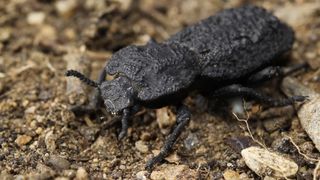You can't squish this 'iron' beetle. Now, scientists know why.
Hardened forewings protect the beetles against piercing and crushing.

Diabolical ironclad beetles are almost unbreakable — you can smack them, stomp on them or run them over with a car, and they'll scamper away uncrushed.
Now, scientists know why these beetles' outer wing cases, known as elytra, are so tough — they're made up of a series of smoothly interlocking puzzle parts; the geometry and internal structure of this "jigsaw" design increase the strength of the beetle's armor.
Ironclad beetles (Phloeodes diabolicus) measure about 0.6 to 1 inch (15 to 25 millimeters) in length, and are found in woodland habitats in western North America, where they live under tree bark. Though their ancestors could fly, ironclad beetles lost their flight capabilities long ago, and their elytra are fused together, forming a crush-resistant shield.
Related: Meet the beetles: Stunning museum specimens from London
Entomologists are all too familiar with the toughness of these barriers. Efforts to pin ironclad beetle specimens for mounting, display and storage frequently end with an unpierced insect and a pile of bent steel pins, scientists wrote in their new study, published online today (Oct. 21) in the journal Nature.
The researchers performed compression tests on the beetles to see just how much force those shields could withstand before cracking. They discovered that the "iron" beetles could resist continuous forces up to 149 newtons, or 33 lbs. (15 kilograms). This was about 39,000 times the beetles' body weight, and more than twice as much force as other species of terrestrial beetles can endure, according to the study.
Jigsaw joins
Microscopic analysis of exoskeleton cross-sections showed lateral support structures that made some parts of the elytra stiffer than others, to distribute weight uniformly over the beetle's back and protect its organs. And further reinforcement came from the seam where the elytra fused together.
Sign up for the Live Science daily newsletter now
Get the world’s most fascinating discoveries delivered straight to your inbox.
In the ironclad beetle's flying relatives, the elytra notch together in "a tongue-and-groove design," allowing them to smoothly open, close and release the lower wings for flight, the researchers reported. But in ironclad beetles, the fused elytra fit together like pieces in a jigsaw puzzle along the length of the insect's abdomen. The protruding parts of these interlocking pieces, called blades, also distribute stress across the exoskeleton, preventing it from cracking.

When the researchers 3D-printed samples to test the strength of the jigsaw connections, they found that sutures with five blades were stiffest and could bear heavier loads. The scientists also detected layered microstructures in cross-sections of the blades that further diverted stresses away from the most vulnerable parts, protecting the narrow "necks" of the interlocking puzzle pieces from fractures and actually causing the pieces to lock together more securely.
Revealing the biological architecture that makes ironclad beetle exoskeletons near-uncrushable could help engineers design structures that are more impact-resistant, and the researchers put this to the test with their own 3D-printed designs.
"We demonstrate this by creating interlocking sutures from biomimetic composites that show a considerable increase in toughness compared with a frequently used engineering joint," the scientists wrote in the study.
Originally published on Live Science.

Mindy Weisberger is an editor at Scholastic and a former Live Science channel editor and senior writer. She has reported on general science, covering climate change, paleontology, biology and space. Mindy studied film at Columbia University; prior to Live Science she produced, wrote and directed media for the American Museum of Natural History in New York City. Her videos about dinosaurs, astrophysics, biodiversity and evolution appear in museums and science centers worldwide, earning awards such as the CINE Golden Eagle and the Communicator Award of Excellence. Her writing has also appeared in Scientific American, The Washington Post and How It Works Magazine. Her book "Rise of the Zombie Bugs: The Surprising Science of Parasitic Mind Control" will be published in spring 2025 by Johns Hopkins University Press.